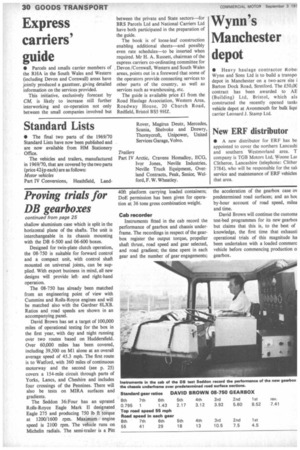Proving trials for lew DB gearboxes
Page 27

Page 32

If you've noticed an error in this article please click here to report it so we can fix it.
he eight speed 08-750 ■ as a 100,000-mile riitial target
• Exhaustive road tests under a variety of typical operating conditions have been intro duced as a feature of the gearbox develop ment work undertaken by David Brown Gear Industries Ltd, of Huddersfield. In particular, a 38-ton-gross Seddon-Pitt artic with 275 bhp Rolls-Royce turbo-charged diesel is at present being used to evaluate the new DB 08-750 gearbox which is due to become available in the spring of next year. This new box has an input torque rating of 750 lb ft at a first speed ratio of 8.52:1.
The proposals for minimum power/weight ratios are among the main factors which, together with the extension of the motorway network, have encouraged David Brown to review both its range of gearboxes and its testing procedures.
New gearbox designs are being prepared on the basis of three main requirements, namely: a. Good gearbox total ratio spread, and adequate bottom gear performance (crawler gear).
b. Overdrive for good motorway performance.
c. To achieve minimum weight; with rationalization of components at economic cost levels.
The first of the new designs will be the 08-750 which is an eight-speed unit designed to suit all independently produced engines appropriate to its capacity; DB claims that by applying a special progression through the ratios and providing optimum spread it has been found possible to design an eight-speed unit with performance characteristics comparable with existing 10-speed transmissions.
The ratios of 08-750 have been selected to combine high motorway performance—
with minimum loss of road speed between ratios—with close ratios for town work, providing good manoeuvrability (at maximum gross weights) down to speeds as low as 3 mph.
This is a range-change box with four ratios at the front of the gearbox and a reduction unit at the rear, which is by passed to obtain the four higher gears. The range change from low to high is by an air operated cylinder which engages a clutch through a synchromesh mechanism. The change from 4th to 5th speed is effected by preselecting high range with a pneumatic switch. The interlocked system prevents the range change operating until the gear lever is moved into neutral before selecting the required gear. The reverse procedure applies for changing down.
Indicator light
An indicator light is provided in the cab to show the driver which range is engaged.
Full power take-off is from the reverse shaft at half engine speed, eliminating the normal step-up gears; only clutch engagement is required.
This new constant-mesh box with profileground, hardened gears is housed in a very shallow aluminium case which is split in the horizontal plane of the shafts. The unit is interchangeable in its chassis mounting with the DB 6-500 and 06-600 boxes.
Designed for twin-plate clutch operation, the 08-750 is suitable for forward control and a compact unit, with control shaft mounted on universal joints, can be supplied. With export business in mind, all new designs will provide leftand right-hand operation.
The 08-750 has already been matched from an engineering point of view with Cummins and Rolls-Royce engines and will be matched also with the Gardner 8LXB. Ratios and road speeds are shown in an accompanying panel.
David Brown has set a target of 100,000 miles of operational testing for the box in the first year, with day and night running over two routes based on Huddersfield. Over 60,000 miles has been covered, including 39,500 on MI alone at an overall average speed of 45.3 mph. The first route is to Watford, with 360 miles of continuous motorway and the second (see p. 25) covers a 154-mile circuit through parts of Yorks, Lanes, and Cheshire and includes four crossings of the Pennines. There will also be tests on MIRA surfaces and gradients.
The Seddon 36:Four has an uprated Rolls-Royce Eagle Mark II designated Eagle 275 and producing 750 lb ft torque at 1200/1600 rpm. Maximum engine speed is 2100 rpm. The vehicle runs on Michelin radials. The semi-trailer is a Pitt 40ft platform carrying loaded containers; DoE permission has been given for operation at 36 tons gross combination weight.
Cab recorder Instruments fitted in the cab record the performance of gearbox and chassis underframe. The recordings in respect of the gearbox register the output torque, propeller shaft thrust, road speed and gear selected, and road gradient; the time spent in each gear and the number of gear engagements; the acceleration of the gearbox case ov predetermined road surfaces; and an hot by-hour account of road speed, milea and time.
David Brown will continue the customa test-bed programmes for its new gearbox but claims that this is, to the best of knowledge, the first time that exhausti operational trials of this magnitude ha been undertaken with a loaded commerc vehicle before commencing production o gearbox.










































































































































